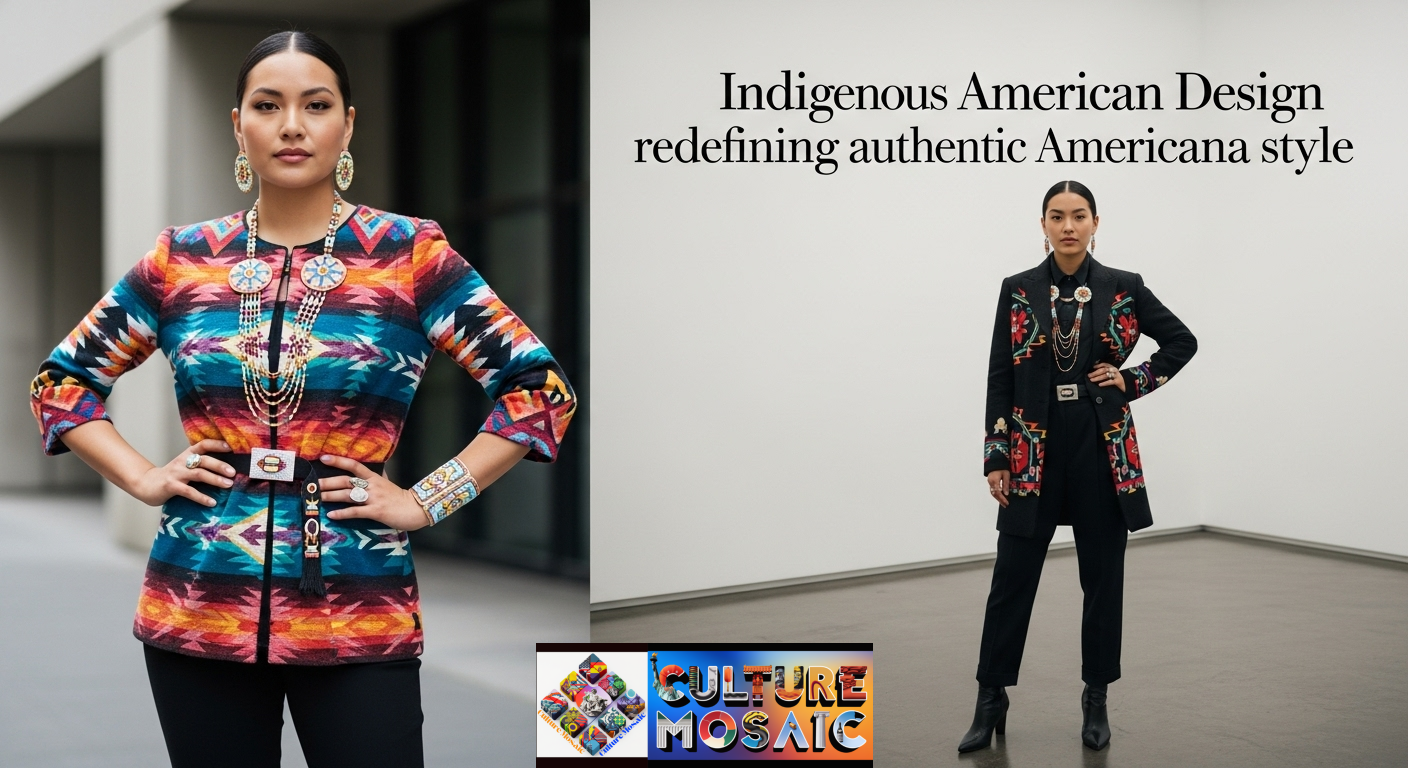When most people think about American heritage fashion, they picture cowboy boots, denim workwear, and maybe a classic Pendleton blanket. But long before these became icons of Americana, the original inhabitants of this continent were creating stunning textiles, intricate beadwork, and innovative designs that have influenced everything from haute couture runways to contemporary streetwear.
Indigenous American Design isn’t just a trend or a niche market. It’s a vibrant, evolving creative movement rooted in thousands of years of knowledge, yet completely relevant to today’s fashion conversations. From Bethany Yellowtail’s bold contemporary silhouettes to the intricate beadwork of Jamie Okuma, Native designers are reclaiming their creative heritage and showing the world what authentic American style really looks like.
What Makes Indigenous American Design Unique
The difference between Indigenous American Design and mainstream fashion goes deeper than aesthetics. Every piece tells a story. When you see a Navajo-woven textile, you’re looking at a technique passed down through generations, where each color choice and pattern carries cultural meaning. When you encounter Coast Salish button blankets or Plains tribes beadwork, you’re witnessing art forms that have survived colonization, forced assimilation, and systematic erasure.
Contemporary Native designers blend these traditional techniques with modern sensibilities. They’re not creating museum pieces meant to be preserved behind glass. They’re making clothes people actually want to wear, accessories that work with contemporary wardrobes, and home goods that feel both timeless and current.
The craftsmanship alone sets Indigenous American Design apart. Consider the time investment: a single beaded medallion might take 40 hours to complete. Navajo weavers can spend months on a single rug, working on traditional upright looms just as their ancestors did. Quillwork, one of the oldest Native American art forms, requires harvesting porcupine quills, dyeing them with natural materials, and applying them one by one. This isn’t mass production. It’s wearable art created by skilled artisans who learned their craft from family members, often starting in childhood.
The Rising Stars of Indigenous American Design
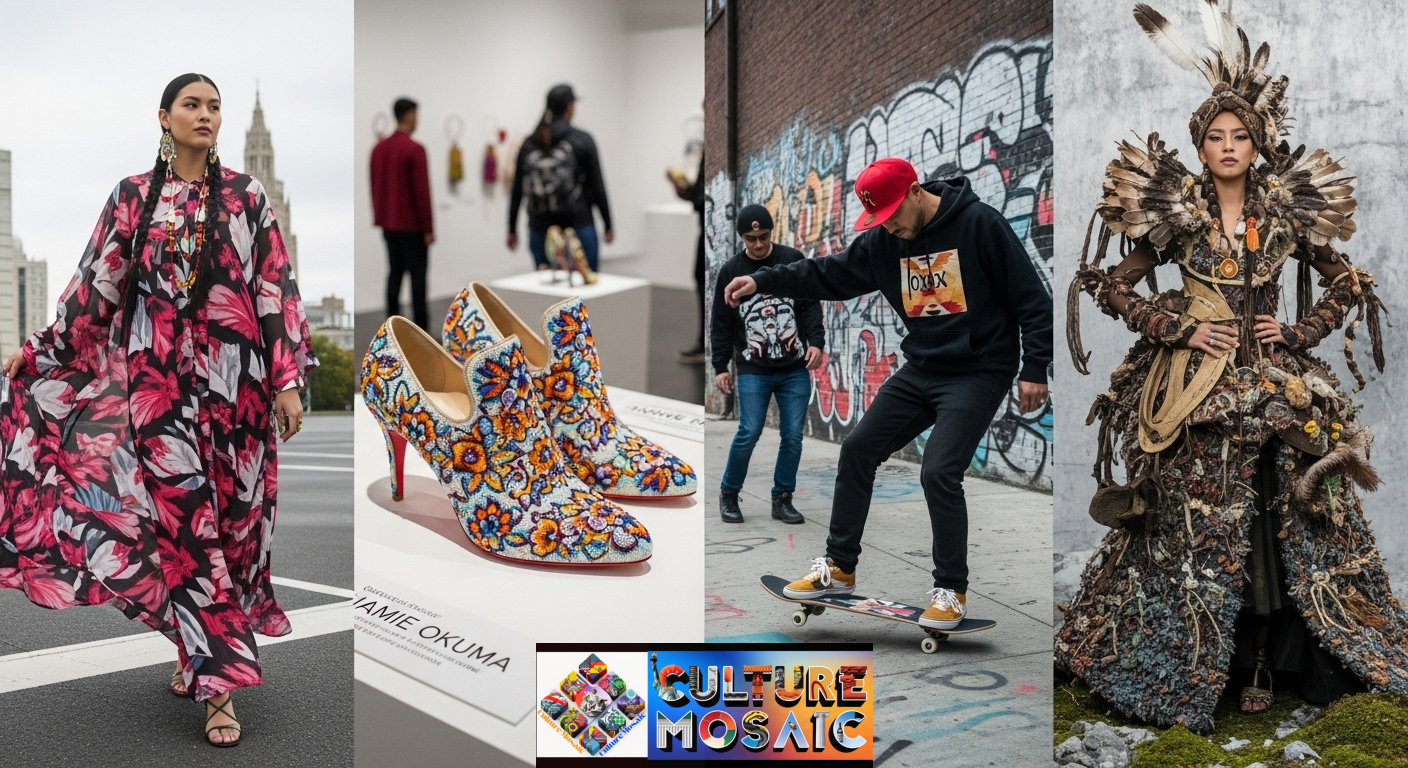
Several Native designers have broken through to national and international recognition, proving that Indigenous American Design can compete at the highest levels of fashion.
Bethany Yellowtail (Northern Cheyenne and Crow) launched B.Yellowtail in 2015 and has since dressed celebrities and shown her collections at major fashion events. Her work features bold prints inspired by traditional designs, flowing silhouettes, and a modern sensibility that appeals to fashion-forward consumers who want meaning behind their purchases.
Jamie Okuma (Luiseño and Shoshone-Bannock) has gained recognition for her incredible beadwork that transforms high-fashion shoes and accessories. Her custom beaded Louboutins have been featured in museums, and her work represents the highest level of technical skill combined with contemporary fashion sense.
Jared Yazzie of OXDX creates streetwear that blends Indigenous iconography with urban style. His designs prove that Indigenous American Design doesn’t have to be traditional in presentation to honor cultural roots.
Patricia Michaels (Taos Pueblo) gained national attention on Project Runway and continues to create stunning pieces that merge traditional techniques with avant-garde fashion. Her sculptural approach to Indigenous materials pushes the boundaries of what people expect from Native design.
These designers aren’t anomalies. They’re part of a larger movement that includes hundreds of Native artists working in fashion, jewelry, textiles, and accessories. Events like the Santa Fe Indian Market draw thousands of visitors and generate millions in sales, proving there’s a substantial appetite for authentic Indigenous American Design.
Understanding Traditional Techniques in a Modern Context
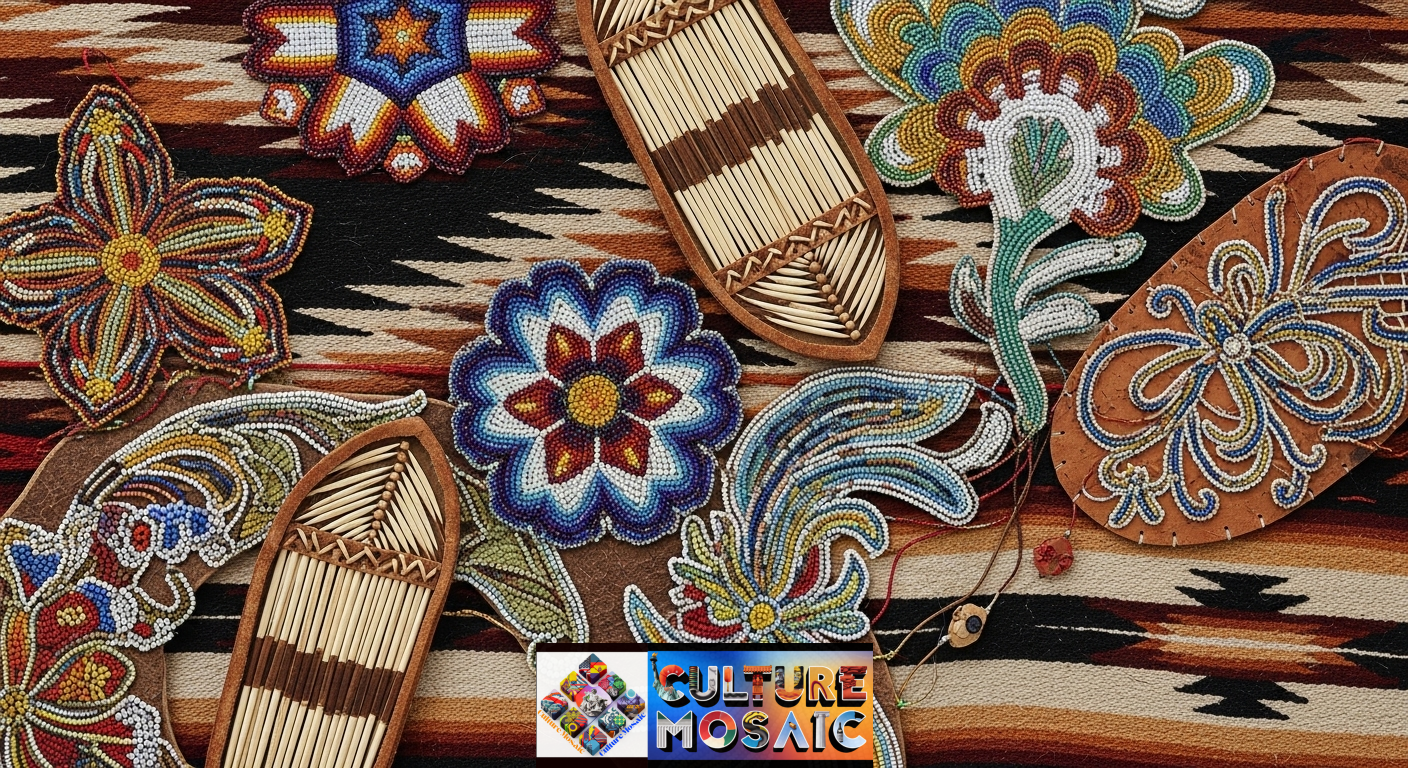
The techniques behind Indigenous American Design represent some of the most sophisticated textile and decorative arts in the world. Understanding these methods helps you appreciate why authentic pieces command their prices and why they deserve recognition as fine art, not just craft.
- Navajo weaving stands as one of the most recognizable forms of Indigenous American Design. Weavers work on upright looms, creating textiles without using patterns or sketches. The designs live in their minds, passed down through observation and practice. Traditional Navajo weavers still use hand-spun wool, often from their own sheep, and natural dyes from plants and minerals. A single textile can take months to complete, with the weaver working standing up, painstakingly passing the weft thread through the warp.
- Beadwork varies dramatically between tribes, with each having distinct styles, color preferences, and pattern traditions. Plains tribes are known for geometric designs in bold colors. Haudenosaunee (Iroquois) beadworkers create intricate floral patterns raised on dark velvet. Métis beadwork features flowing, organic floral designs. These aren’t interchangeable styles. Each represents a specific cultural tradition with its own rules and meanings.
- Quillwork predates beadwork in many Native cultures. Artisans harvest porcupine quills, flatten them, dye them using natural materials, and then apply them to leather or birch bark in intricate patterns. This painstaking process requires specialized knowledge about preparing materials and applying quills in various techniques, including wrapping, folding, and stitching.
- Coast Salish weaving creates textiles from mountain goat wool and other materials using distinctive techniques that produce blankets and clothing with spiritual and ceremonial significance. The designs follow specific rules and often indicate family lineages and tribal affiliations.
When contemporary designers incorporate these techniques into modern pieces, they’re not just using interesting textures. They’re keeping alive knowledge systems that were nearly lost. Many Native languages and cultural practices were deliberately suppressed through boarding school systems and assimilation policies. When you wear Indigenous American Design created using traditional methods, you’re supporting cultural survival.
The Real Cost of Authentic Indigenous American Design
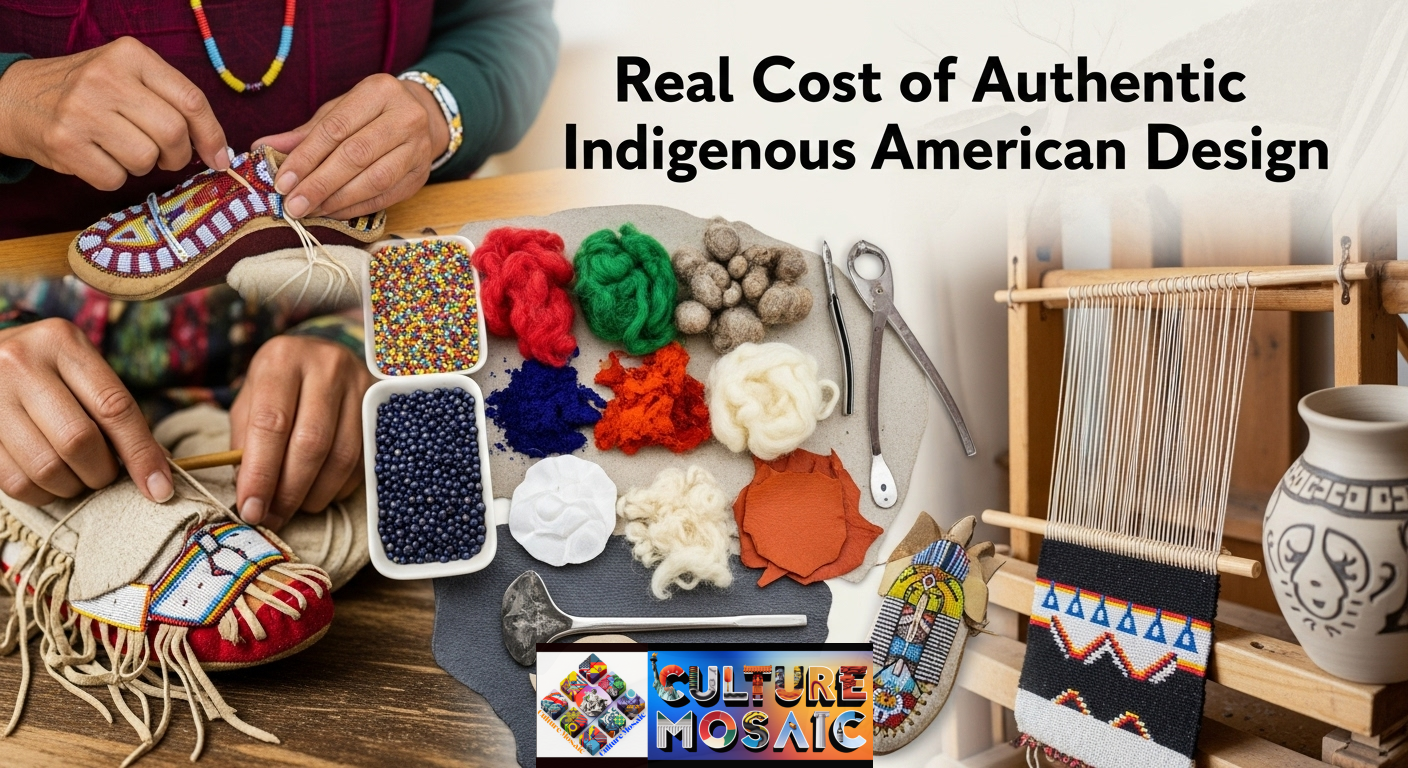
One of the most common questions about Indigenous American Design concerns pricing. Why does a beaded clutch cost $800? Why is that woven textile $3,000? Understanding the economics helps explain why authentic pieces cost what they do and why those prices are more than fair.
First, consider the time investment. A pair of fully beaded moccasins might represent 60 to 80 hours of work. If you calculate even a modest hourly wage, the material costs (quality beads, leather, thread), and the overhead of running a small business, suddenly that $600 price tag makes sense. In fact, many Native artists are dramatically undercharging for their work when you break down the actual labor involved.
Second, you’re paying for expertise that took years to develop. Many Native artists began learning their craft as children, spending thousands of hours developing the skills to create professional-quality work. That beadwork didn’t come from a YouTube tutorial. It came from sitting with grandmothers and aunties, learning techniques through observation and correction, understanding cultural protocols about designs and colors.
Third, authentic materials cost money. Natural dyes, hand-spun wool, brain-tanned leather, genuine silver, and quality beads all carry higher price tags than synthetic alternatives. Many artists insist on traditional materials because they matter to the integrity of the work.
When you buy Indigenous American Design directly from artists or Native-owned businesses, your money supports entire families and communities. It allows parents to stay home and create rather than leave for urban jobs. It helps fund language revitalization programs, ceremonial activities, and cultural education for younger generations. Your purchase isn’t just buying a beautiful object. It’s an investment in cultural survival.
How to Support Indigenous American Design Ethically
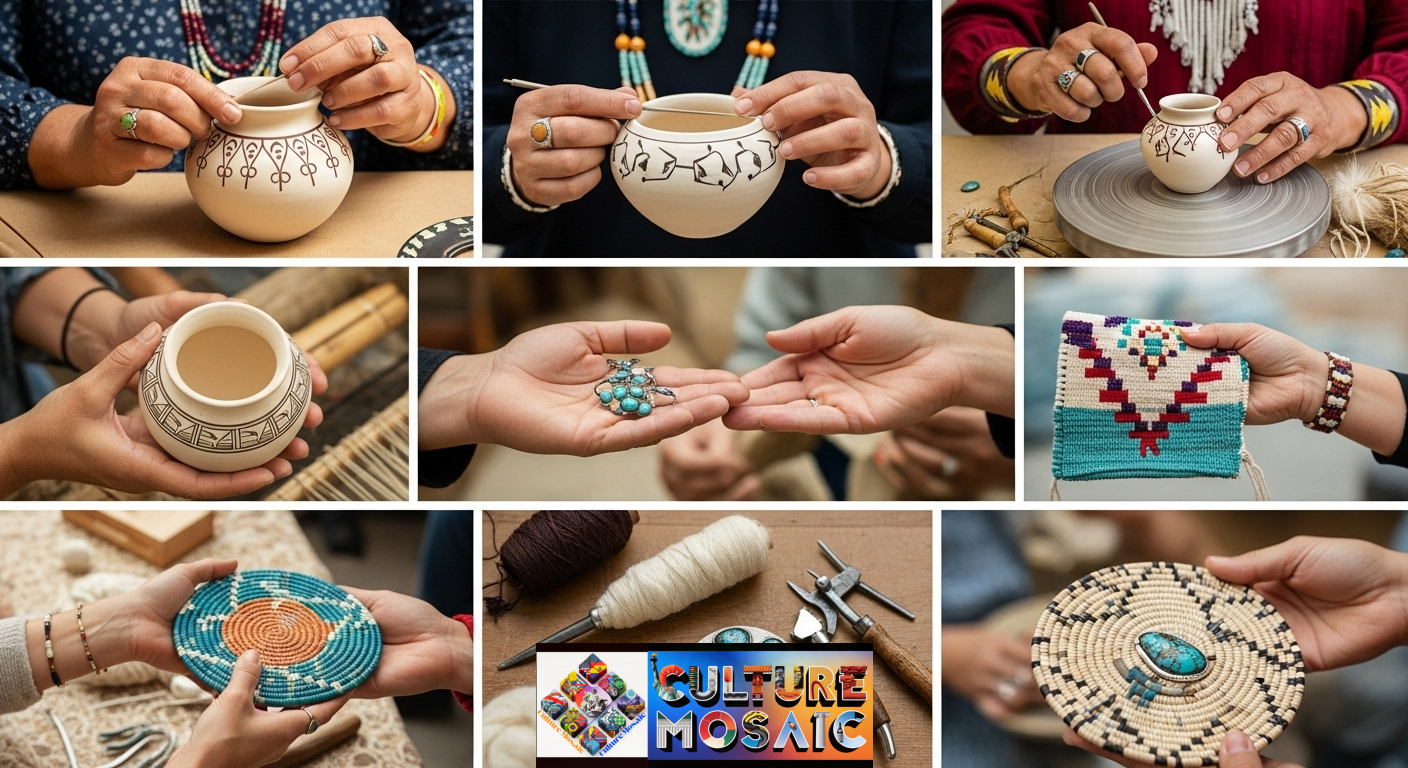
The growing interest in Indigenous American Design is wonderful, but it requires consumers to educate themselves about ethical purchasing. The line between cultural appreciation and appropriation isn’t always obvious, but here are clear guidelines for engaging with this heritage respectfully.
- Buy directly from Native artists and businesses. This ensures your money goes to the actual creators and culture-bearers. Look for businesses that are tribally owned or operated by enrolled tribal members. Events like the Santa Fe Indian Market, Heard Museum Guild Indian Fair & Market, and the Gathering of Nations provide opportunities to meet artists and purchase directly. Online, platforms like Beyond Buckskin Boutique, Eighth Generation, and individual artist websites make it easier to find authentic work.
- Understand what you’re buying. Ask questions about the artist’s background, which tribe they belong to, and the significance of the designs. Reputable sellers welcome these conversations. Be suspicious of “Native-inspired” or “Southwest-style” products from non-Native companies. These descriptions often signal cultural appropriation, where corporations profit from Indigenous aesthetics without compensating or crediting Native communities.
- Recognize the difference between authentic and appropriation. Genuine Indigenous American Design comes from the hands and minds of Native people. Mass-produced items featuring generic “tribal” patterns, sold by non-Native companies, take income away from Native artists while perpetuating stereotypes. Companies like Urban Outfitters have repeatedly faced criticism for selling items that copy Native designs without permission or compensation.
- Learn about specific tribal aesthetics. Not all Indigenous American Design is interchangeable. Designs often have specific tribal origins and meanings. What’s appropriate for one tribe might be sacred or restricted in another. Part of respecting this heritage means understanding these distinctions rather than treating all Native design as a monolithic style.
- Support year-round, not just during November. Native American Heritage Month brings welcome attention, but Native artists need consistent support. Follow Native designers on social media, sign up for their newsletters, and consider them when you need gifts throughout the year.
- Credit and tag artists. If you share photos of Indigenous American Design pieces on social media, always credit the artist and tag their accounts. This visibility helps them gain followers and potential customers. It also educates your network about authentic sources for Native-made goods.
Indigenous American Design in Contemporary Fashion
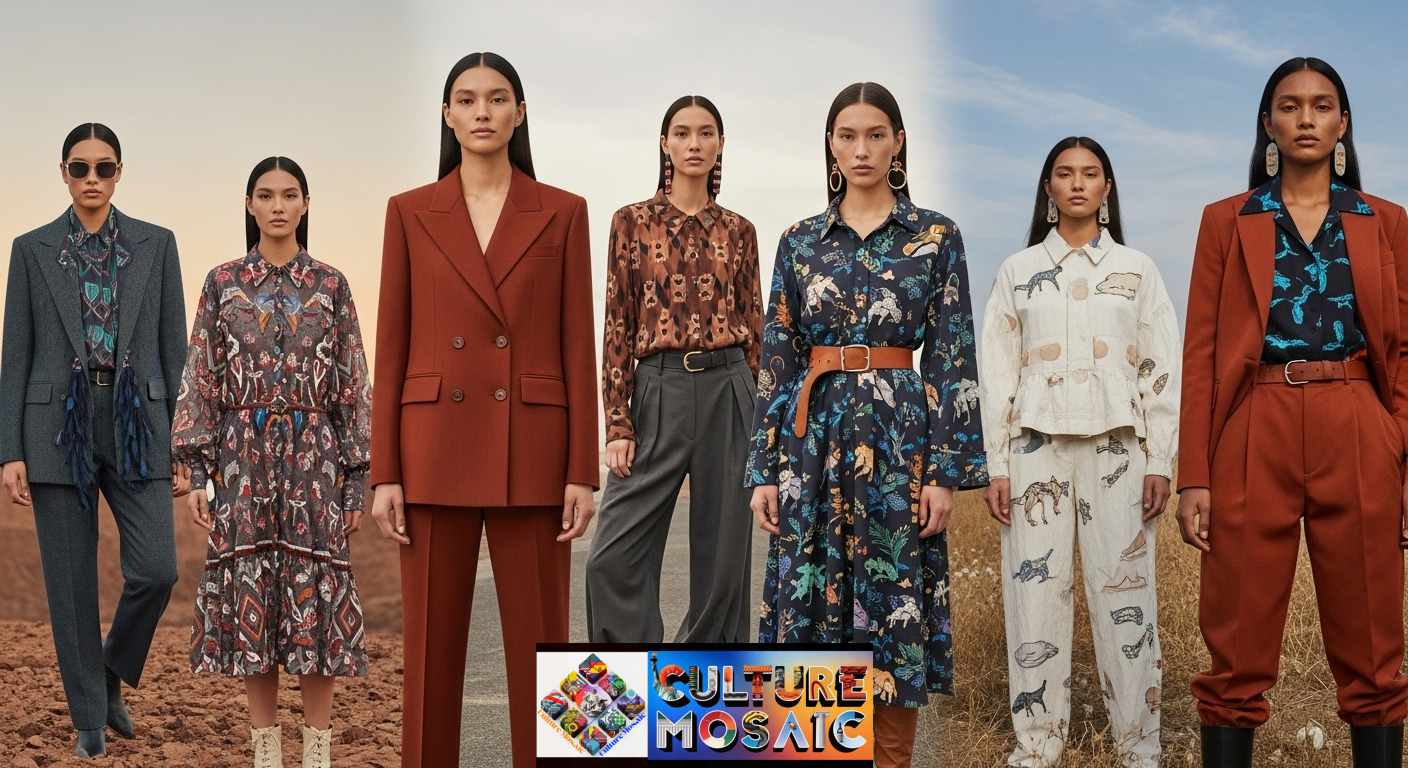
The influence of Indigenous American Design extends far beyond Native communities. Major fashion houses have repeatedly drawn inspiration from Native aesthetics, though not always ethically or with proper credit. Understanding this complex relationship helps consumers make better choices.
High-fashion designers like Ralph Lauren, Donna Karan, and Isabel Marant have all faced criticism for collections that borrowed heavily from Indigenous designs without acknowledging the source or including Native collaborators. These controversies highlight an important principle: inspiration requires acknowledgment, compensation, and respect.
However, positive collaborations are increasing. Pendleton, the iconic blanket company, works with Native designers to create collections where artists receive credit and compensation. These partnerships show how non-Native companies can engage with Indigenous American Design respectfully.
The streetwear and skateboarding industries have also embraced Indigenous American Design, with varying degrees of thoughtfulness. Brands like Nike’s N7 line, created specifically for Native communities with input from Native designers, represent respectful engagement. Other companies have simply slapped “tribal” patterns on products without understanding their significance.
Contemporary Native designers are increasingly controlling their own narratives. Rather than waiting for mainstream fashion to acknowledge them, they’re building direct-to-consumer brands, collaborating, and creating platforms that center Native creativity. Instagram and other social media platforms have allowed Indigenous American Design to reach global audiences without requiring validation from traditional fashion gatekeepers.
The Cultural Significance Behind the Designs
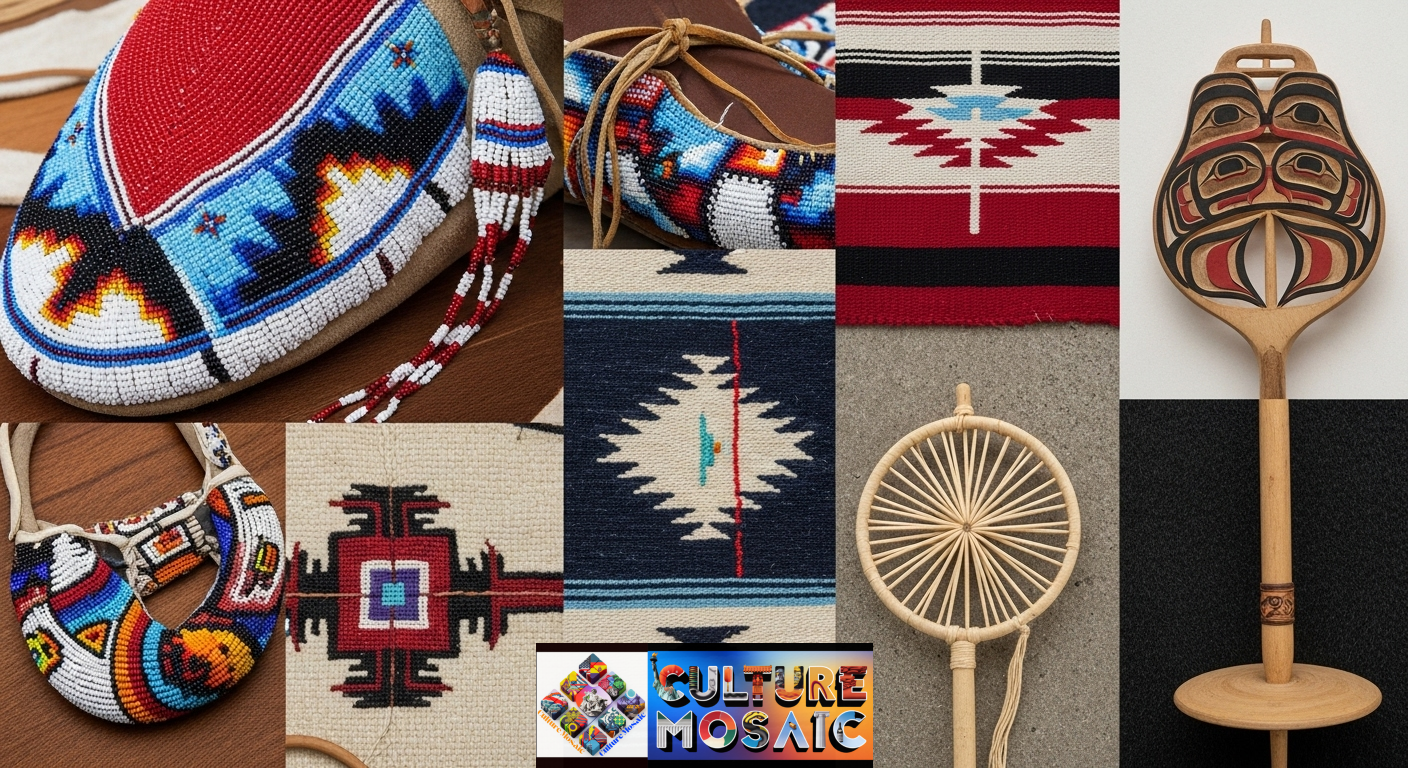
Every element of Indigenous American Design carries meaning. Colors, patterns, materials, and construction methods all communicate cultural knowledge. Understanding this depth transforms these items from pretty things into profound cultural texts.
In many Plains tribes’ traditions, beadwork colors have specific associations. Red might represent life force or sacred earth. Blue could symbolize sky, water, or spirituality. White often indicates purity, while black might represent night or facing west. These aren’t universal meanings. Each tribe maintains its own color symbolism, and designs often tell specific stories or indicate family affiliations.
Navajo textile patterns follow cultural rules about design and construction. Traditional weavers leave a deliberate imperfection called a “spirit line” that allows the weaver’s energy to flow out of the piece. The four sacred colors of Navajo cosmology (white, blue, yellow, and black) often appear in traditional designs, representing the four sacred mountains and directions.
Coast Salish designs are so specific that knowledgeable community members can identify the weaver’s family and origin based on pattern choices. These aren’t decorative flourishes. They’re visual records of genealogy and tribal affiliation.
When contemporary Indigenous American Design incorporates these elements, artists walk a careful line. They honor traditional meanings while creating new interpretations appropriate for contemporary contexts. Sacred designs typically remain in ceremonial contexts, while public designs find new life in fashion and home goods.
This cultural literacy matters for consumers, too. When you wear or display Indigenous American Design, you’re participating in these knowledge systems. Respectful engagement means understanding that your beautiful beaded clutch or woven textile represents more than skilled handwork. It embodies cultural continuity, resistance against erasure, and the ongoing creativity of living cultures.
Where to Find Authentic Indigenous American Design
Finding genuine Indigenous American Design requires knowing where to look. Fortunately, the internet has made it easier than ever to connect directly with Native artists and businesses.
Major Native art markets provide concentrated opportunities to see and purchase work from hundreds of artists. The Santa Fe Indian Market, held annually in August, is the largest and most prestigious, featuring over 1,000 artists from more than 200 tribes. The Heard Museum Guild Indian Fair & Market in Phoenix showcases top artists in a more intimate setting. The Gathering of Nations Market in Albuquerque combines with the world’s largest powwow, offering a festival atmosphere alongside serious art sales.
Online platforms have democratized access to Indigenous American Design. Beyond Buckskin Boutique curates contemporary Native fashion from multiple designers. Eighth Generation, a Native-owned company, creates contemporary Coast Salish-inspired goods and provides a platform for other Native artists. Many individual artists maintain their own websites and Etsy shops, though verification of authenticity becomes important on larger marketplaces.
Museum shops at institutions like the Smithsonian’s National Museum of the American Indian, the Heard Museum, and the Institute of American Indian Arts often carry work by Native artists, with proceeds supporting both artists and the institution’s educational mission.
Native-owned boutiques and galleries exist in cities across the country, not just in the Southwest. These businesses provide year-round access to Indigenous American Design and often develop relationships with artists, offering custom commission services.
Direct from artists remains the best option when possible. Following Native designers on Instagram, Facebook, and other platforms lets you purchase directly, learn about their processes, and build relationships with the people behind the work.
When shopping, look for clear information about the artist’s tribal affiliation, business ownership, and design origins. Reputable sellers provide this information prominently. Be wary of vague terms like “Native-inspired,” “Southwest-style,” or “tribal” without specific attribution to Native creators.
The Future of Indigenous American Design
Indigenous American Design is experiencing a renaissance. Young Native designers are attending fashion schools, gaining business skills, and creating brands that honor their heritage while speaking to contemporary aesthetics. This movement represents more than fashion trends. It’s part of a broader cultural revitalization happening across Native communities.
Social media has revolutionized how Native artists reach audiences. Instead of relying on galleries, museums, or retailers that take significant commissions, artists can showcase their work directly to global audiences. Instagram, in particular, has allowed Indigenous American Design to find customers who value authenticity, craftsmanship, and cultural significance.
Technology is also helping preserve and teach traditional techniques. While nothing replaces learning directly from family and community members, video tutorials and online workshops help geographically dispersed Native people reconnect with their cultural practices. Virtual markets and online sales platforms ensure that artists in remote reservation communities can access broader markets.
Younger generations are innovating while respecting tradition. They’re asking questions like: What does contemporary beadwork look like? How can traditional weaving techniques create modern furniture or architectural elements? Can streetwear aesthetics honor Indigenous identity? These explorations push Indigenous American Design forward while maintaining connections to cultural roots.
The conversation around cultural appropriation has also shifted in Native communities’ favor. More consumers understand why buying authentic Indigenous American Design matters and why “Native-inspired” products from non-Native companies are problematic. This awareness creates market pressure for ethical engagement with Native creativity.
Looking forward, the challenge lies in scaling Indigenous American Design businesses while maintaining quality and cultural integrity. Some Native designers are exploring ways to train more artisans, create cooperative business models, and pass traditional knowledge to younger generations while building sustainable enterprises.
Why Indigenous American Design Matters Beyond Fashion
The significance of Indigenous American Design extends far beyond beautiful clothing and accessories. This creative movement represents cultural survival, economic sovereignty, and the reclamation of narratives that were nearly erased.
For decades, the dominant American narrative presented Native people as historical figures, frozen in time before colonization. Museums displayed “traditional” Native arts while ignoring contemporary Native creativity. This erasure had real consequences, reinforcing stereotypes and denying Native people full participation in modern society.
Indigenous American Design challenges these narratives by demonstrating that Native cultures are living, evolving, and innovative. When a Native designer shows at New York Fashion Week or sells out an online collection, they prove that Indigenous creativity is contemporary and relevant. This visibility matters for Native youth who need to see their cultures celebrated rather than relegated to history books.
Economic impact is equally important. Many Native communities face significant poverty, with limited job opportunities on remote reservations. Indigenous American Design creates income that stays in Native communities, reducing dependence on outside employment and allowing families to remain on their ancestral lands. When artists succeed, they often hire family members, teach traditional techniques to younger relatives, and support cultural activities.
The environmental consciousness embedded in many traditional practices also offers relevant lessons for contemporary sustainability conversations. Native artists often prioritize natural materials, traditional harvesting practices, and designs built to last rather than follow fast-fashion cycles. These approaches align with growing consumer interest in ethical, sustainable fashion.
Finally, Indigenous American Design preserves knowledge that could otherwise be lost. Languages die with their last speakers. Art forms disappear when no one learns them. Every artist creating traditional beadwork, weaving, or quillwork is maintaining a thread of cultural continuity. They’re living examples that colonization didn’t succeed in erasing Native cultures.
Conclusion
Indigenous American Design represents the true heritage of this continent, offering depth, meaning, and craftsmanship that mass-produced fashion can never match. When you choose to support Native designers and artists, you’re not just buying beautiful things. You’re participating in cultural survival, economic justice, and a more honest conversation about what “authentic Americana” really means.
The next time you think about American heritage style, look beyond cowboy boots and denim. Consider the intricate beadwork of Plains tribes artists, the sophisticated weaving of Navajo and Coast Salish traditions, and the innovative contemporary designs from Native fashion houses. These are the original American designers, and their work continues to set the standard for creativity, craftsmanship, and cultural integrity.
Supporting Indigenous American Design starts with education and intention. Buy directly from Native artists and businesses. Learn about the tribal origins and cultural significance of designs. Understand that authentic pieces cost what they do for good reasons—share and credit Native creators. Engage year-round, not just during heritage months.
The fashion world is finally beginning to recognize what Native communities have always known: Indigenous American Design offers something genuinely special, rooted in thousands of years of knowledge yet completely relevant to contemporary style. By supporting this movement, you become part of a story about respect, survival, and the enduring creativity of this land’s original inhabitants.
Frequently Asked Questions About Indigenous American Design
How can I tell if Indigenous American Design is authentic?
Authentic Indigenous American Design comes from Native artists or Native-owned businesses. Look for clear information about the artist’s tribal affiliation and enrollment status. Reputable sellers provide this information prominently. Be cautious of items labeled “Native-inspired,” “Southwest-style,” or “tribal” without specific attribution. Purchasing from Native art markets, museum shops, or verified Native-owned online platforms ensures authenticity. When in doubt, ask direct questions about the artist’s background and tribal membership.
Why does authentic Indigenous American Design cost more than mass-produced alternatives?
The pricing reflects actual labor costs, skilled craftsmanship, and quality materials. A single beaded piece might require 40 to 80 hours of work from an artist who spent years developing their skills. Traditional materials like hand-spun wool, brain-tanned leather, and natural dyes cost more than synthetic alternatives. When you buy authentic pieces, you’re paying artists fairly for specialized knowledge passed down through generations. These aren’t factory-produced items. They’re individual artworks that support Native families and cultural preservation.
What’s the difference between cultural appreciation and appropriation when it comes to Indigenous American Design?
Cultural appreciation means supporting actual Native artists, learning about the cultural significance of designs, and giving credit where it’s due. Appropriation occurs when non-Native companies copy Indigenous designs without permission, credit, or compensation to Native communities. Buying a beaded clutch from a Native artist is appreciation. Buying a mass-produced “tribal” pattern from a fast-fashion brand that doesn’t employ or compensate Native people is appropriation. The key difference is whether Native people benefit and maintain control over their cultural heritage.
Can non-Native people wear Indigenous American Design?
Yes, when purchased authentically from Native artists and businesses. Native designers create work intended for sale to all customers who appreciate their craftsmanship and culture. The issue isn’t who wears Indigenous American Design, but rather where they buy it and how they engage with it. Purchase directly from Native sources, learn about what you’re wearing, credit the artist when sharing on social media, and understand the cultural context. This respectful engagement supports Native artists economically while honoring their creativity.
Where can I find contemporary Indigenous American Design online?
Several platforms specialize in authentic Indigenous American Design. Beyond Buckskin Boutique curates contemporary Native fashion from multiple designers. Eighth Generation offers Coast Salish-inspired goods and features other Native artists. Many Native designers maintain individual websites and social media shops where you can make direct purchases. Museum shops like those at the Heard Museum or the Smithsonian’s National Museum of the American Indian offer online shopping. Following Native designers on Instagram often leads to discovering new artists and upcoming sales or collections.

